According to recent real estate data, homebuyers often encounter red flags during property showings that indicate underlying issues without realizing it. These indicators serve as important considerations for potential buyers in making informed decisions, especially in special cases such as home auctions or short sales.
This article outlines several warning signs and what they mean for buyers before making an offer on a home. Analyzing these red flags can provide valuable insights into a property’s condition and potential drawbacks to purchasing that can save you money and prevent buyer’s remorse.
Increased knowledge of red flags can also help prospective buyers identity specific issues that they can safely accept, potentially giving them buying power in a competitive market. This list of red flags can assist homesellers, as well, as it can help sellers envision how their homes may be perceived by prospective buyers, and what should be addressed prior to listing.
Table of Contents
- 15 Red Flags to Look For During Home Showings
- Red Flags That Can Be Buying Opportunities
- Conclusion: Understand the Red Flags in Homes Before You Buy
Also see:
15 Red Flags to Look For During Home Showings
- Limited Listing Photos
- Misleading Virtually Staged Photos
- An Unexpectedly Low Price
- Roof, Attic, & Shingle Problems
- Foggy or Stuck Windows
- Water Damage
- Cracked Foundation
- Signs of Mold
- Signs of Deferred Maintenance
- The Home Has Fallen Out of Escrow Multiple Times
- The Buyer’s Agent is Also the Seller’s Agent
- Recent or Rushed Renovations
- Too Many Nearby Homes are For Sale at the Same Time
- Neighborhood Noise Levels and Problematic Neighbors
- Poor Documentation or a Missing Homeowner Binder
1. Limited Listing Photos
Before even attending a home showing, red flags can start to be noticed in online listings. A limited number of photographs in the listing could suggest the intentional omission of specific rooms or sections of the house.
When a listing lacks an adequate representation through high-quality images, prospective buyers should inquire about the reasons behind this omission. Seeking assistance from an agent can help obtain previous photos of the property from past listings before scheduling a house tour. In cases where certain rooms have been deliberately excluded from the listing, it is important to ask for an explanation.
This red flag should not be taken lightly, as it may indicate potential concerns regarding the property. If no photographs are provided whatsoever, it might suggest that either the property is in poor condition or the seller lacks motivation to invest the effort of adding visual aids.
The absence of visual representation leaves potential buyers with minimal information and raises questions about what may be hidden or undisclosed about certain aspects of the house.
Buyers must exercise caution when faced with limited listing photos and gather all necessary information before making any decisions or commitments regarding a property purchase.
Below is an example of purposefully omitting interior photos of a rancher, built in 1954, for sale in Pebble Beach, California. Though the listing includes rendered elevation drawings for a to-be-built replacement home, it is unclear if the asking price was dropped accordingly.

Image courtesy of Redfin
Also see:
2. Misleading Virtually Staged Photos
Another type of red flag to look for before visiting a property in person is a listing that includes misleading virtually staged photos, especially virtual renovation photos.

Example of a misleading sunset with the Sun placed in the wrong direction
Image courtesy of BoxBrownie & Realtor Magazine
Though we are strong proponents of using both virtually staged photos and virtual renovation photos in online real estate listings, our support always comes with the stipulation of responsibly labeling any and all virtual images.
In addition to overlaying text that denote a given image is “virtual”, sellers should denote any virtual images used in a listing should also have a corresponding “real” photo so that viewers can understand the current state of a room, and its future potential, including potential “to-be-done” renovations.
For example, a common scenario of presenting a virtually staged room will be to show a real photo of an empty room, with a corresponding virtually staged image that contains realistic looking interior design elements (e.g. furniture, rugs, décor items, wall art, and window treatments).
Since virtual renovation images can vary dramatically from an existing space, it is especially important to share realistic photos of a given room. As long as real photos are included, in tandem, virtual photos can help prospective buyers envision the underlying potential for a given home.
Another important aspect of responsibly created virtual photos is that permanent features outside of the control of the homeowner should never be removed. Examples of this type of permanent features would include: telephone poles; utility boxes; USPS mailboxes; nearby buildings; and street signs. However, permanent features in the control of the homeowner (e.g. light fixtures; wall cladding; non-load-bearing walls; kitchen appliances; etc.) that are removed would need to be labeled as virtual renovations.
Also see:
- The Many Benefits of Virtual Staging
- 7 Expert Tips on Using Virtual Staging to Sell Your Home Quickly
- A Quick Overview of Virtual Renovations
- A “Before” vs. “Virtual” vs. “Real Life” Renovation Case Study
- Box Brownie: How to Market Ethically with Virtual Staging in Real Estate
- Realtor Magazine: The Worst Offenses in Virtually Staged Photos
3. An Unexpectedly Low Price
An unexpectedly low price for a property may indicate underlying issues requiring further investigation before proceeding with a purchase.
When a property is listed at a significantly lower price than comparable homes or current market rates, it is important to exercise caution and delve deeper into the reasons behind this seemingly incredible offer.
While the sellers may be motivated by financial constraints or personal circumstances, there is also the possibility that the property itself has significant flaws or defects. Consult an agent to uncover the underlying factors contributing to properties listed well below market value.
Purchasing a property that has been priced well below market value without fully understanding the reasons behind it can lead to unexpected expenses and complications.
For example, if you move into a house only to discover its septic system malfunctions or sewage leaks into your shower, you’ll have to face costly repairs and renovations. Therefore, allocating sufficient time and resources is crucial to thoroughly inspect the property and to understand the unusual price discount.
Another reason for a low asking price may be to fuel a bidding war. An initial bargain asking price can attract several well-qualified bidders that can all become emotionally determined not to lose out on this “bargain”.
4. Roof, Attic, & Shingle Problems
Roof, attic, and shingle problems can be identified by carefully examining indicators such as missing or damaged shingles, curling edges, cracks, exposed nail heads, and inadequate ventilation.

These issues are red flags during property viewings and should not be overlooked. By recognizing these warning signs, prospective homeowners can make informed decisions and potentially avoid costly repairs in the future.
To further assist in identifying roof-related problems, here are some additional indicators to consider:
- Missing or Damaged Shingles: Water can easily enter the attic, and the roof may require immediate attention or replacement.
- Improperly Installed or Missing Drip Edge Flashing: Rain water should be diverted away from the house with properly installed flashing.
- Curling Edges: Shingles that show signs of curling suggest age or poor installation and may lead to leaks if left unaddressed.
- Cracks: Cracked shingles can compromise the roof’s integrity and allow water penetration and ultimately ceiling and wall damage to the home’s interior.
- Exposed Nail Heads: This is a clear sign of improper installation and increases the risk of water damage.
- Inadequate Ventilation: Insufficient airflow in the attic can result in excessive heat buildup, potentially damaging the roof’s sheathing and shingles.
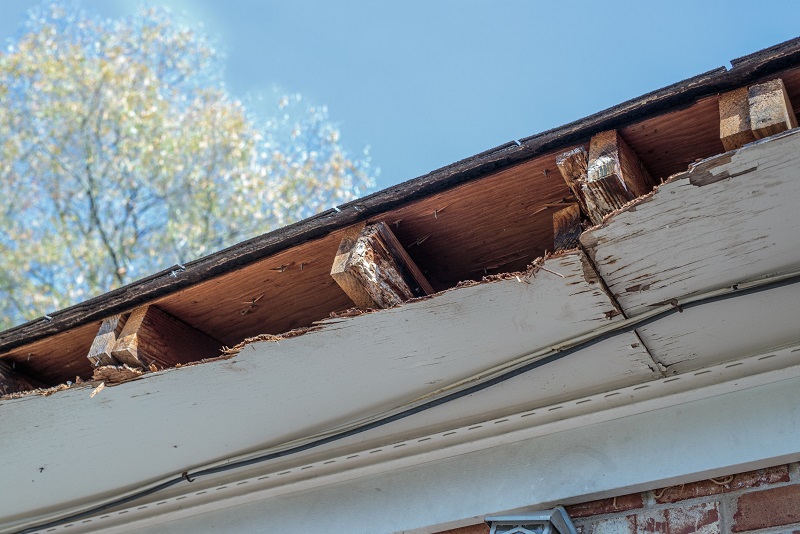
Properties that need a new roof can prove to be a red flag buying opportunity under the right circumstances. First, the prospective buyer can ask for a new roof to be installed or an in-kind financial concession. If the request can be granted and completed within an appropriate timeframe (e.g. before the start of the rainy season), this can serve as a mutually beneficial resolution.
Also see:
5. Foggy or Stuck Windows
Foggy or stuck windows can indicate potential issues with insulation and installation, compromising energy efficiency and overall comfort within the dwelling.
When windows exhibit a foggy appearance, it signifies a seal failure, which can lead to escalated utility expenses and thermal imbalances within the home.

Fog between the glass panes indicates the deterioration of the window’s seals, allowing moisture-laden air from outside to infiltrate and condense on interior surfaces. This not only creates an unsightly appearance but also reduces energy efficiency.
There are six warning signs to be mindful of when checking if windows may have a problem.
- Visible moisture or fog is trapped between the window panes
- Water stains on or around the window frames
- Cracked or peeling paint on window sills or around frames
- Softening or “mushy to the touch” drywall near and around windows and door frames
- Mold or mildew near the window vicinity
- Difficulty opening and closing windows
Addressing foggy windows quickly is crucial. Replacement with modern, energy-efficient alternatives or installing Insulated Glass Units (IGUs) without completely replacing the windows can ensure adequate insulation and lower utility expenses while providing a comfortable living environment.
Also see:
6. Water Damage
Water damage can lead to significant structural and aesthetic issues if not addressed promptly. It is crucial to identify signs of water damage during property viewings to avoid potential complications in the future.
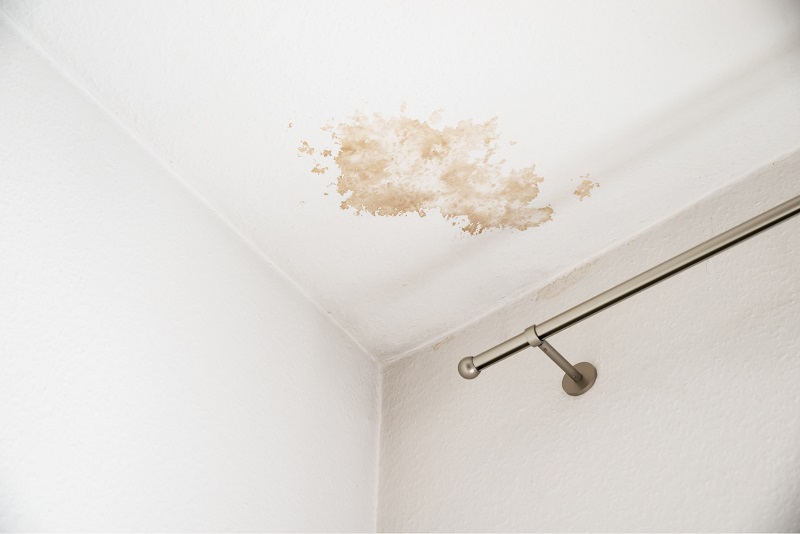
Here are three water-related red flags to look for during showings and what they mean:
Also see:
1. Water Stains
Extensive water staining on floors, ceilings, or walls can result in discolored paint, surface irregularities, and rough textures. These issues not only affect the property’s visual appeal but also raise concerns about its structural soundness. Additionally, multiple water stains throughout the property indicate a higher probability of underlying problems.

2. Bubbles Beneath the Surface
Bubbles underneath exterior surfaces, such as vinyl siding, suggest insufficient sealing or the need for replacement. Internally, these bubbles might indicate leaky roofs or pipes that require attention.
3. Musty Odor
Even without visible standing water, a musty odor can be a sign of water damage and possibly mold or mildew issues. This could indicate flooding resulting from leaks or burst pipes that may have caused concealed internal damage.
It is important to seek confirmation from a professional inspector for any suspected water damage to determine the extent of the problem and make informed decisions about purchasing a property.
7. Cracked Foundation
Identifying cracks in a house’s foundation is crucial during property viewings, as they can indicate potential structural instability and property damage.
When assessing a house’s foundation, it is imperative to conduct a meticulous examination of any signs of damage. Cracks that exceed one-third of an inch in width are considered “structural” cracks and may signify structural issues with the house. These cracks are commonly observed in concrete walls and can compromise the home’s stability, leading to leaning or tilting if left unresolved.
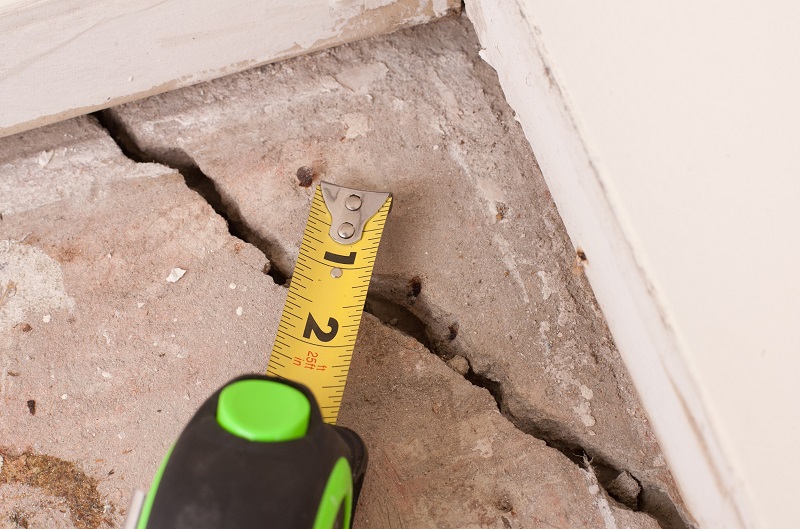
On the other hand, ‘nonstructural’ cracks, although not impacting the home’s structural integrity directly, still require attention as they can serve as habitats for pests or contribute to mold growth beneath the house. Furthermore, nonstructural cracks blemish the structure’s appearance and diminish its resale value.
During property showings, prospective homeowners should carefully evaluate cracked foundations due to their potential implications for structural issues and property damage. It is important to consider both ‘structural’ and ‘nonstructural’ foundation cracks when deciding to purchase a house.
Houses often exhibit hairline cracks as they naturally settle over time. However, significant gaps signal more substantial concerns with the home’s foundation. Other indicators of foundation issues include doors or windows that stick, visible cracks above window frames, and uneven floors, which can be assessed by placing a marble or golf ball on them to see if it rolls in any particular direction.
8. Signs of Mold
Cracked foundations can indicate underlying property issues, such as water intrusion and moisture problems. These conditions can create an environment conducive to mold growth.

Tube Slime Mold
Mold, although not always toxic, can adversely affect human health when its spores are inhaled. Therefore, prospective homebuyers need to remain attentive to any signs of mold during property viewings.
When exploring an open house, several red flags may suggest the presence of mold:
Musty Odor
A moldy smell is often a clear indicator of mold growth within a property. It is essential to investigate further if such an odor is detected.
Visual Signs
Black or gray spots on surfaces like walls, ceilings, or carpets may indicate the presence of mold. Inspecting areas beneath sinks and around windows can provide valuable insights into potential leaks and subsequent mold growth.
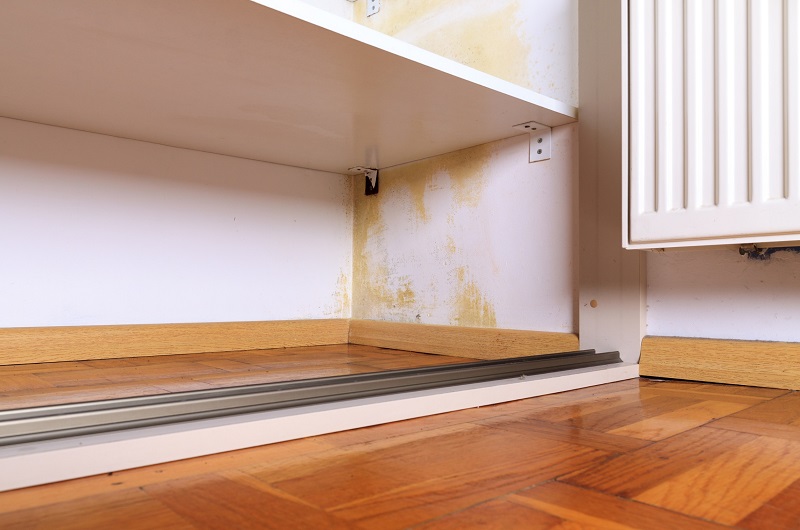
Understanding these signs and their implications can help potential homeowners make informed decisions regarding the suitability of a property for purchase. It is advisable to seek professional assistance from home inspectors or specialized companies offering mold testing services for a definitive assessment of a property’s mold status.
By maintaining vigilance towards these red flags during showings, individuals can ensure their well-being and long-term satisfaction as homeowners.
9. Signs of Deferred Maintenance
Deferred maintenance in a property refers to the postponement or neglect of routine repairs and upkeep, which can lead to potential issues and costly repairs in the future.

Indications of deferred maintenance can include:
- Burnt-out lightbulbs
- Overgrown grass
- Dripping faucets
- Faded paint
These signals suggest that the homeowner may have neglected other ongoing maintenance responsibilities that could result in significant problems down the line.
Vigilant homeowners typically engage in regular practices such as:
- Annual water heater flushing
- Monthly air filter replacements
- Chimney cleaning
- Roof leak inspections
- Recaulking around windows and doors
By adhering to these practices, homeowners can ensure the proper functionality of various systems within their properties.
When viewing a property with signs of deferred maintenance apparent at first glance, it is important to consider the potential revelations that may arise during a comprehensive home inspection. Neglected maintenance issues can indicate underlying structural problems or faulty systems requiring costly repairs or replacements.
Therefore, buyers should approach properties with deferred maintenance issues cautiously and assess whether they are willing to invest time and money into addressing these issues after purchasing the property.
Overall, recognizing signs of deferred maintenance during showings is crucial for buyers as it allows them to make informed decisions about prospective properties based on their desired level of investment and willingness to undertake necessary repairs or renovations.
Also see:
10. The Home Has Fallen Out of Escrow Multiple Times
When visiting a prospective home to purchase, it is imperative to research the recent history of the home. Specifically, you will want to know if a given property has been listed with different real estate agencies in recent months or years, and if this property has fallen out of escrow and for what reasons.
When encountering a property of this kind, be sure to inquire as to the reasons for the sales not going through. If the reason has to do with “recently discovered defects”, the seller’s agent is obligated by law to disclose to prospective buyers any “known issues” with the property.
11. The Buyer’s Agent is also the Seller’s Agent
Though paradoxical, it is legal in many states for a licensed real estate agent to represent both the buyer and the seller. This situation, referred to as Dual Agency, represents an inherent conflict of interest, as it is impossible for an agent to get the best asking price for the seller, while simultaneously getting the best sales price for the buyer.
If you ever find yourself in this situation you will want to hire an independent buyer’s agent, someone whose financial incentive is not solely tied to this specific home.
The “non-paradoxical” or ethical scenario of dual agency occurs typically during the transfer of property between family members or between individuals who have already agreed upon a sales price prior to enlisting a licensed agent.
Also see:
12. Recent or Rushed Renovations
Though many prospective homebuyers are seeking turnkey move-in ready properties, not all renovations are equal and many poorly executed renovations may not be worth the risk of taking ownership.
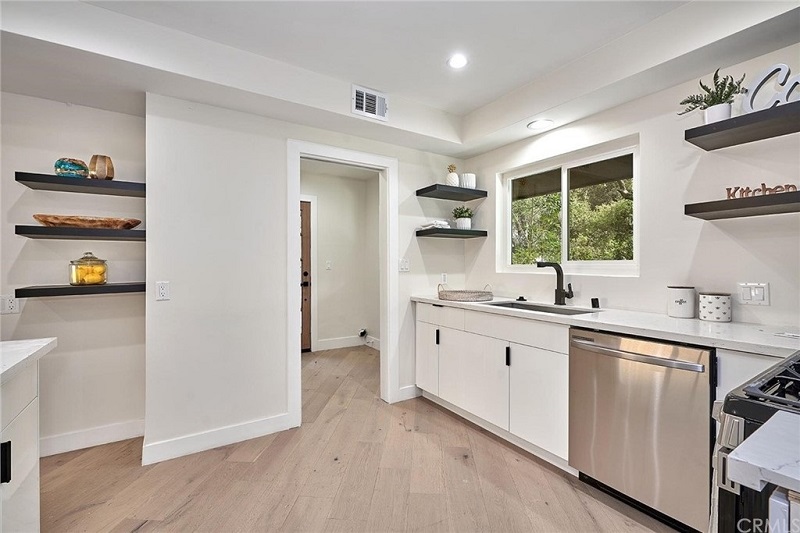
Renovated kitchen of a flipped house without space for a standard-size refrigerator
When considering purchasing a recently renovated home, ask to review all documentation of plans, permits, photos and videos to gain a solid understanding of the quality of the work conducted. A lack of documentation or a hesitancy to share project details are both red flags.
Inconsistencies in paint color or visible repairs might also suggest that the property was hastily prepared for the showing. These cosmetic fixes could be hiding more significant problems.
Conversely, when purchasing a flipped house, be sure to ask for references of other homebuyers that bought a previously flipped home by the same contractor. A lack of stellar references is another red flag to note.
Also see:
13. Too Many Nearby Homes are For Sale at the Same Time
This is an especially serious red flag for prospective buyers that may be relocating to a new area and who are unfamiliar with recent trends and planned changes to the community.

Example underlying causes for a mass exodus could be:
- Rising Crime
- Rising Property Taxes
- Approved Development Plans that may negatively impact quality of life
- Change in Air Traffic Patterns
- Geographic Threats e.g. mudslide area, landslides, etc.
Also see:
14. Neighborhood Noise Levels and Problematic Neighbors
While at the showing, take a moment to listen to the noise levels in the area and look around at your potential future neighbors. Excessive noise from nearby traffic or loud, disruptive neighbors might impact your comfort in the home.
As part of the process of vetting a prospective home, we encourage multiple trips through the neighborhood at various times of the day and week to get a sense of the pulse of neighborhood.

For example, we once considered a swank Mediterranean home in a nearby town of Los Angeles, only to have (fortunately) witnessed a neighbor across the street blaring loud music from the porch of his home, with no end in sight. That scene in combination with the poor condition of his home was enough for us to say “no thanks, we’ll pass”.
Keep in mind if you have concerns over nearby homes, other prospective buyers will, too, when it comes time to reselling the home, if you choose to make the purchase.
Also see:
15. Poor Documentation or a Missing Homeowner Binder
Many red flags can be categorized as risky “unknowns”, where you can see evidence of issues such as mold or water damage, but you may not have confidence in knowing what the underlying root causes may be.
A home that does not come with a comprehensive homeowner binder with records of home maintenance, appliance purchases, product and service warranties, and contact information of home contractors, adds further to “risky unknowns”.
Without this vital collection of records and documentation a home will lack continuity of care.
Also see:
Red Flags That Can Be Buying Opportunities
When exploring and inspecting homes you are considering purchasing, it’s important to keep in mind that not all “red flags” are deal killers. This approach is especially imperative for bargain hunters, as this house hunting method inherently involves accepting a “less-than-perfect” home.
In other words, the “red flags” of homebuyers with whom you are in competition, may not be red flags for you.
Key to finding bargains that work for you is to have a combination of strengths and advantages on your side:
- You have patience: you can live with imperfections while conducting renovations over time
- You possess DIY home improvement skills: you can cost-effectively make upgrades and repairs that the average homebuyer may lack
- You’re focused on a home with good bones in a great neighborhood: you have vision and knowledge to identify a “diamond in the rough” home that can be transformed to a spectacular residence over time
- You can recognize and understand the importance of an honest and transparent seller: an honest and transparent seller with ample documentation will make it easier for you to assess if a “less-than-perfect” house is a good fit for your skills, temperament and near-term plans
Here are a few example red flags that can potentially signal buying opportunities:
- Lots of Houses for Sale in the Neighborhood
- An Exposed Home with Many To-Be-Done or In-Progress Renovations
- Many Lacking or Missing Amenities
- Tiny House on a Large Lot
- Inaccurate Consensus Opinion for a Given Market
Also see:
Lots of Houses for Sale in the Neighborhood
If a major employer has shuttered or relocated their headquarters out of state, this could represent a terrific buying opportunity for a buyer unaffected by these local economic events.
An Exposed Home with Many To-Be-Done or In-Progress Renovations
The advantage of buying an exposed and unfinished home is that you can investigate the structure and “bones”. For example, we have seen some flipped homes on the market in recent months that we expected the eventual buyer to redo some or many of the completed renovations.
Also see:
Lacking or Missing Amenities or Features
When searching for a home to buy, we always recommend “loosening” your “must have” search criteria you use on the major real estate listing sites. In our case, we were able to find the home we eventually purchased by simply changing “2.5 baths” to “2 baths”. It turns out that the layout of this particular home really does not require a small powder room.
More importantly, we suspect fewer buyers were aware of this listing because of this “missing feature” and even fewer bothered to visit the property to our good fortune!
Tiny House on a Large Lot
As we have written before, owning a large lot is incredibly valuable for many reasons, but a big reason is flexibility and options to handle future life changes. A tiny house can be razed to be replaced by a larger home, or it can simply be made larger.
An ADU (or two) can also be added to your lot for a wide range of uses.
Also see:
Inaccurate Consensus Opinion for a Given Market
This is another red flag pertaining to the neighborhood and local area. Some homeowners may be pessimistic on the future of a community, while other prospective buyers may be optimistic on what the future holds. Red flags pertaining to the current state of a community may be inaccurate and turn out to be short-lived under the right situations that can be confirmed with creative and dogged research.
Conclusion: Understand the Red Flags in Homes Before You Buy
As you view homes with the intent to purchase, it’s important to keep red flags like these in mind. By arming yourself with an understanding of these red flags, you can make informed choices, ensuring that the home you purchase is everything you want it to be. Some can even be used to your advantage as a buying opportunity!
In real estate, an informed approach is paramount, and it can be the difference between finding your perfect home and buying a home that will need expensive and distressing repairs for years to come.
More Recommended Home Buying Articles
- Benefits of Using a Real Estate Agent Instead of an iBuyer
- 8 Common Mistakes Made When Budgeting for a New Home
- 7 Questions to Ask Your Banker When Applying for a Home Loan
- How to Profit from the Misfortunes of Opendoor & Other iBuyers
- Want the Best Mortgage Deal? Study APRs vs. Interest Rates!
- Want a Nontraditional House? Here’s How to Finance It!
- Real Estate Love Letters: Are They Legal?
- Options for Millennials Determined to Own a Home
- Related Topics: Mortgages | Home Buying | Real Estate | Proptech
| Purgula is reader-supported. When you click on links to other sites from our website, we may earn affiliate commissions, at no cost to you. If you find our content to be helpful, this is an easy way for you to support our mission. Thanks! Learn more. |







